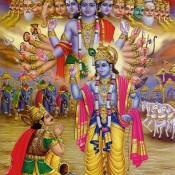
B is for the Bhagavad Gita. This is a beautiful book and an ancient Sanskrit text which dates back 5000 years and forms 700 verses in the epic Mahabharata. Poetic and lyrical, the Bhagavad Gita is also called the Song of the Divine One where Arjuna represents Man and Krishna represents God.
The actual content is a conversation between Krishna and Arjuna on the battlefield at Kurukshetra, just before the war is about to begin. Arjuna is confused and in a dilemma about fighting against his loves ones and possibly killing them in the process. Krishna, his charioteer, motivates him by pointing out his duties as a Kshatriya warrior and Prince, drawing from examples and analogies from Vedanta philosophy.

As Arjuna asked questions Krishna answered them and thus was born The Gita as we know it. In course of his discourse, Krishna reveals that he is the Supreme Being and blesses Arjuna with a glimpse of his divine form.

I grew up with the Bhagavad Gita as a part of my routine since my Grandmother read it almost every day and I was privileged to listen to her perceptions of the text mixed with wisdom. And the most important learning was that There is Only One God.
But how do we know that? Is there proof? I believe there is. In spite of the Big Bang Theory, I am convinced that creation is a work of a supreme being. We see creation in the form of life in various forms and species. There is the Sun that shines down on everyone with the same love, rising and setting. Seasons come and go. (Not saying I am thrilled with the hot sweaty weather where I live right now…still)
I think of irreversible processes such as the cow eating grass and water and producing milk. And man transforms this one product into several others. Trees and plants bear fruits and vegetables.
Then we have those events /calamities that we call Acts of God – earthquakes, floods, hurricanes.
Many aspects related to the functioning of our Universe are mysteries and it is easier to attribute these to a higher power.
There are the things we do not have control over – like old age, death and disease. (No – forget the anti-aging creams – they just don’t cut it!)
I am sure you’ve contemplated on all these things too.
Should you read the entire Bhagavad Gita to benefit from its teachings?
It is not mandatory to read the entire 700 verses (though it makes for a wonderful read) to glean the spiritual wisdom from the Bhagavad Gita.
One of the unique teachings of the Bhagavad Gita is the Karma theory. (I am saving that up for another post!) I secretly think of it as Tit for Tat as in “As you sow, so shall you reap” Every action has an equal and opposite reaction. Sound familiar?
A quick summary of the Bhagavad Gita
Okay – let me try to summarize the Bhagavad Gita for you. It teaches one how to live, how to do one’s duty, taking on the pressures of life and living purposefully and responsibly. It teaches one to live with self-discipline, a stable mind and detachment.
- Each one of us is spiritual. Our spiritual self is immortal and indestructible
- Our monkey mind is full of desires, thoughts and feelings. Often this can lead to conflicting emotions and egoistic thinking. Eventually this results in an unstable mind. Self-discipline can help overcome this and achieve a serene, tranquil mind.
- We must not be attached to the outcome while doing our duty. The wise man acts without attachment. I confess that this one is a tough baby for me. I have miles to go before I finally sleep.
कर्मणये वाधिकारस्ते मां फलेषु कदाचन । मां कर्मफलहेतुर्भू: मांते संङगोस्त्वकर्मणि ।।
Bhagavad Gita, Chapter II, Verse 47.
Translated, this means:
Your right is to work only,
But never to its fruits;
Let not the fruits of action be thy motive,
Nor let thy attachment be to inaction.
- Self-realization and true peace comes only when one has self-control. This is also about letting go of all attachment.
- Treat all beings equally
- God lives in each one of us. Meditation and Yoga are excellent practices to appreciate this. This one I like. I see the divine in everyone.
- Surrender to God with devotion
- Recognize and overcome the three “gunas” – sattva, rajas and tamas to attain salvation. Sattva has to do with all that is pure, Rajas is to do with passion and Tamas with ignorance.
In short, it is all about doing one’s duty with a sense of detachment, self-discipline and a steady mind, letting go of egoism and all those other negative qualities. It is also about not worrying about the outcome and surrendering to the Supreme Power.
“Do your duty to the best of your ability without worrying about the results. Perceive that God is present equally in all beings and treat all beings equally.”
To me, this beautiful book is a spiritual awakening.
What do you think of the Bhagavad Gita’s teachings?
Today’s free download:
Feel like reading the Bhagavad Gita? Here is a simple version you can download for free courtesy the International Gita Society.
Bhagavad Gita for Children and Beginners – (links directly to the pdf file):
This is in the form of a dialog between a child and his Grandmother and is a very enjoyable read.


